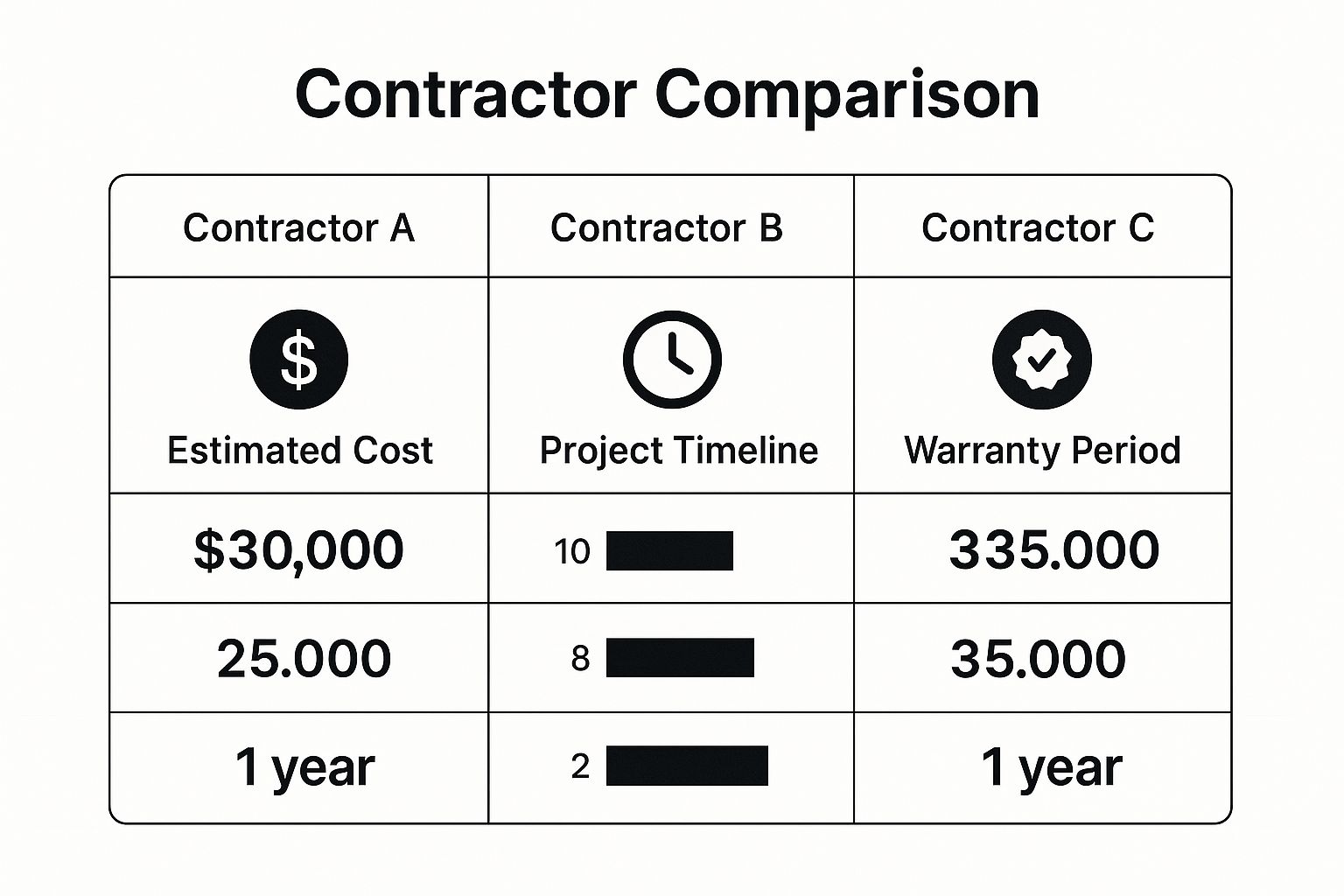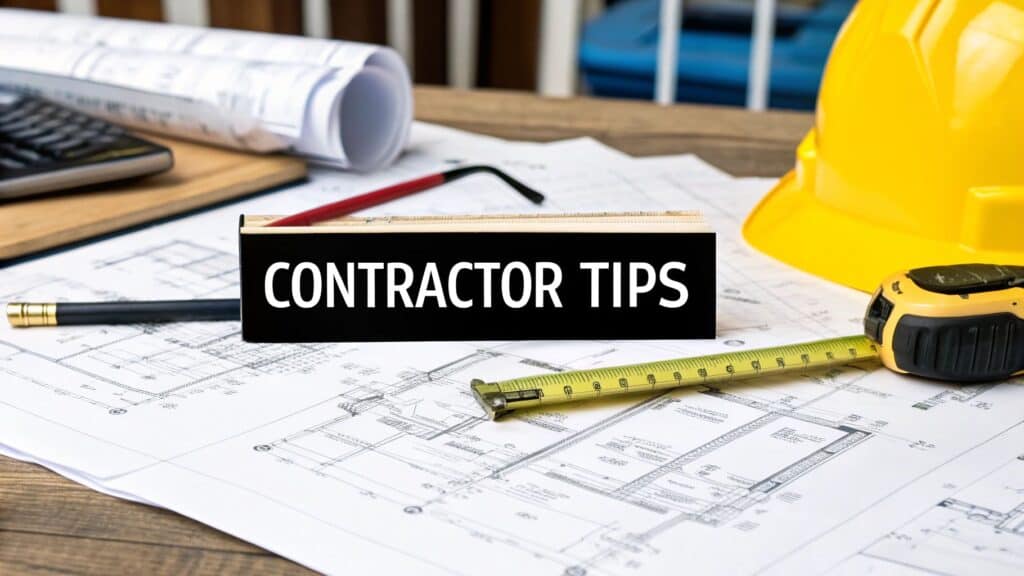Figuring out how to choose a contractor for a kitchen remodel is the single most important decision you’ll make for your entire project. The right partner transforms your vision into a stunning reality with precision and skill. The wrong one can lead to budget overruns, frustrating delays, and unnecessary stress.
The goal isn’t just to find someone who can build cabinets; it’s to partner with a licensed, insured, and reputable professional who will protect your investment and deliver a kitchen you’ll love for years to come. As a BBB Torch Award Winner for Ethics serving Orange County, we understand that this choice is built on trust.
Your Foundation for a Flawless Kitchen Remodel
A kitchen remodel is far more than a construction project—it’s a significant investment in your home’s value and your family’s daily life. The contractor you hire is the conductor of this complex process, tasked with turning your ideas into a functional, beautiful reality. Their role truly sets the tone for the whole experience, from the first design sketch to the final punch list.
Think of your contractor as your project partner, not just a builder. They are responsible for managing timelines, coordinating specialized trades (plumbers, electricians, tile setters), pulling permits, and tackling the unexpected issues that invariably arise. A great professional brings calm to the potential chaos, ensuring your project stays on schedule and on budget. This is especially true in discerning communities like Newport Beach and Irvine, where homeowners expect—and deserve—uncompromising quality and precision.
The Importance of Professional Guidance
If you’re feeling the need for an expert to guide you, you’re not alone. Recent data shows that around 50% of U.S. homeowners hire a general contractor for their kitchen remodel. This statistic highlights that most people recognize the value of expert management for a project of this scale and complexity.
A smooth process hinges on a deep understanding of every moving part, from knowing structural requirements to guiding material selections. For instance, something like choosing the right countertops seems straightforward, but a contractor’s real-world guidance on durability, maintenance, and installation intricacies is invaluable. It’s one of those decisions that dramatically impacts both the aesthetic and usability of your new kitchen.
To help you get started, we’ve put together a quick checklist that summarizes the key vetting steps. Think of it as your guide for sorting the true professionals from the rest.
Quick Guide Contractor Vetting Checklist
| Vetting Step | Why It Matters | What to Look For |
|---|---|---|
| Verify License & Insurance | Protects you from liability and ensures they meet California’s stringent standards. | A valid CSLB license, proof of general liability, and workers’ compensation insurance. |
| Check Reviews & References | Past performance is the best indicator of future results and client satisfaction. | A mix of online reviews (Google, Yelp) and direct calls to at least three recent local clients. |
| Review Their Portfolio | You need to see if their style and quality match your vision for your home. | High-quality photos of completed kitchens similar in scope and style to yours in Orange County. |
| Get a Detailed Bid | Vague estimates lead to surprise costs and project delays. | An itemized bid that breaks down costs for labor, materials, permits, and fees. |
| Assess Communication Style | You will be in constant communication for weeks or months. | Are they responsive, professional, and clear? Do they listen to your concerns? |
This table covers the essentials, but remember, the best partnerships go beyond a simple checklist. You are entrusting a team with your home for an extended period.
Choosing a contractor isn’t about finding the lowest price; it’s about securing the best value. This means partnering with a team that has verifiable credentials, transparent processes, and client-focused communication to protect your investment and peace of mind.
Ultimately, investing time in vetting your contractor is the smartest thing you can do to safeguard your project. A full-service firm can make this even simpler. For example, our integrated design-build services at Sparkle Restoration provide a single point of contact and responsibility from concept to completion. This approach is the foundation of a truly successful, stress-free renovation, ensuring a cohesive journey from the first sketch to the final reveal.
Building Your Shortlist of Trusted Contractors

This is where your vision begins to take shape. Building a list of potential contractors is the first tangible step in your remodeling journey. While a referral from a friend or neighbor is a fantastic starting point, a truly solid shortlist requires more thorough due diligence.
Your mission is to find a handful of highly qualified, reputable professionals whose work genuinely resonates with your vision for your Orange County home. Think of this initial research phase as validating their credibility before you even pick up the phone. The difference between a smooth, predictable remodel and a chaotic one often comes down to the quality of this early vetting.
Do not rush this stage. Taking the time now to meticulously check credentials and portfolios will save you from significant headaches down the line.
Verifying Credentials The Right Way
In California, a contractor’s license is your first line of defense, but simply confirming they have one isn’t enough. You must dig a little deeper to fully understand a contractor’s history and professional standing.
The California State License Board (CSLB) is an indispensable resource. Here’s how to use it effectively:
- Check the License Status: First and foremost, is the license active and in good standing? An expired or suspended license is an immediate disqualification.
- Look for Disciplinary Actions: The CSLB website transparently lists any public complaints or disciplinary actions filed against a contractor. A clean record is a strong indicator of professionalism and reliability.
- Confirm the Classification: For a full kitchen remodel, you need a contractor with a General B (General Building Contractor) license. This classification is critical because it means they are legally permitted to manage the entire project and coordinate all specialized trades.
Beyond the CSLB, two other non-negotiable credentials protect you, your home, and every person on the job site:
- General Liability Insurance: This covers accidental property damage or injuries that could occur during the remodel. Without it, you could be held financially responsible for any mishaps.
- Workers’ Compensation Insurance: This is mandatory for any contractor with employees and protects you from liability if one of their workers is injured on your property.
Ask to see a certificate of insurance for both. Any legitimate, professional contractor, like Sparkle Restoration Services, will provide these documents without hesitation.
Hiring an unlicensed or uninsured individual to save money is a massive gamble. It exposes you to immense financial risk, offers no legal recourse for substandard work, and often leads to more expensive repairs later on.
Analyzing Portfolios for a Perfect Match
Once you’ve confirmed a contractor’s credentials, it’s time for the engaging part: assessing their work. A portfolio is more than a gallery of photos; it’s a direct window into their capabilities, design aesthetic, and quality of craftsmanship.
When reviewing past projects, look for proof that they have successfully completed projects similar to yours in both scale and style. A contractor who primarily does small bathroom updates may not be the right fit for a large-scale, high-end kitchen overhaul in Newport Beach.
As you browse their gallery, ask yourself these questions:
- Does their work align with my personal taste (modern, traditional, transitional)?
- Have they worked on homes in Orange County that are similar in size and value to mine?
- Is the quality of the finish work—the details in cabinetry, tile, and trim—consistently high across all projects?
- Do they showcase a variety of projects, or does it appear they apply the same design repeatedly?
This critical review helps you filter out contractors who aren’t a good stylistic or logistical fit, narrowing your list to those who truly understand the level of quality you expect.
Seeking Out Reputable Sources
Beyond personal referrals and company websites, where else can you find contractors you can trust? Third-party validation from industry associations provides an invaluable layer of confidence. Look for affiliations with respected organizations or awards that speak to a company’s commitment to quality and ethics.
For instance, being a BBB Torch Award Winner for Ethics isn’t just a plaque; it signifies a proven history of transparency, integrity, and client trust. Likewise, advanced certifications, such as being an IICRC Master Certified firm, demonstrate a deep-seated commitment to industry best practices and technical excellence.
These accolades act as powerful, independent endorsements, helping you separate the true professionals from the rest. By combining these research methods, you’ll build a shortlist of contractors you can genuinely trust to bring your dream kitchen to life.
Asking Questions That Reveal True Expertise

Once your shortlist is ready, it’s time to conduct interviews. This is your opportunity to move beyond what looks good on paper and get a real feel for a contractor’s process, communication style, and problem-solving abilities. You’re aiming to separate the seasoned professionals from the slick talkers.
The key is to ask intelligent questions that go far beyond, “How much will this cost?” A genuinely experienced contractor won’t offer canned answers; they’ll demonstrate a deep understanding of the entire remodeling journey, from navigating specific building codes in Orange County to handling unforeseen challenges.
Their responses—or lack thereof—will tell you everything you need to know about their project management style and whether they truly prioritize their clients.
Going Beyond the Basics
Anyone can promise a beautiful kitchen, but excellence lies in the details of their process. You want to understand how they operate, especially when things don’t go perfectly. A remodel is a dynamic project, and the best contractors have systems in place to handle the unexpected with calm competence.
Begin with questions that get to the heart of their operational readiness and experience.
- Project Management & Communication: How will they keep you informed? Do they use project management software, a group chat, or daily check-ins? A clear communication plan is a hallmark of an organized, professional operation.
- Team & Subcontractors: Ask if they have an in-house crew or rely on subcontractors. If they use subcontractors, find out how long they’ve worked together. A long-standing relationship with trusted tradespeople is a strong indicator of quality and reliability.
- The Permitting Process: Have them walk you through the permitting process for your specific city, whether it’s Irvine, Newport Beach, or another Orange County location. A local expert will know the municipal requirements and timelines intimately.
The most revealing conversations are not about best-case scenarios; they’re about how a contractor handles challenges. A professional who can confidently explain their process for dealing with unexpected issues is one you can trust with your home and investment.
Probing for Problem-Solving Skills
This is where a contractor’s experience truly shines. Kitchen remodels are notorious for uncovering hidden issues—outdated plumbing, faulty wiring, or structural quirks. A seasoned professional has seen it all and already has a contingency plan.
Pose a few hypothetical scenarios to see how they think on their feet. Their answers should be clear, logical, and focused on solutions, not excuses.
For instance, ask: “Can you walk me through how you’d handle finding significant water damage behind the old cabinets once they’re torn out?”
A great answer will involve these four steps:
- Immediate Action: They would immediately pause work in that area to prevent further damage and properly assess the situation.
- Clear Communication: They would contact you right away to explain the issue, provide photographic evidence, and discuss potential impacts on the budget and timeline.
- Solution-Oriented Options: They would present clear, itemized options for remediation, explaining the pros and cons of each approach.
- Formalizing the Change: They will describe how this additional work would be documented in a formal change order, ensuring no surprises on the final invoice.
This type of response demonstrates transparency and a partnership approach. A vague or dismissive answer, on the other hand, is a significant red flag.
Understanding Their Business Practices
Finally, ask questions that reveal their professionalism and business acumen. These details speak volumes about their stability and how they value client relationships, while also clarifying expectations around finances and logistics.
Consider asking these questions:
- Material Procurement: “What is your process for ordering materials and managing supplier timelines to avoid delays?” This reveals their supply chain management skills, which are critical for keeping a project on schedule.
- Warranty: “What kind of warranty do you offer on your workmanship?” A reputable contractor will always stand behind their work with a clear, written warranty.
- Payment Schedule: “What does your payment schedule typically look like?” Payments should always be tied to completed project milestones, never arbitrary dates.
- Project Cleanup: “How do you manage dust and debris during the project? What will the job site look like when your team leaves each day?” A commitment to cleanliness shows respect for your home and a high level of professionalism.
By digging in with these detailed, process-focused questions, you empower yourself to make a truly informed decision. You’re not just hiring someone to build a kitchen; you’re entrusting them with one of the most important spaces in your home. Ensure they’ve earned that trust.
How To Evaluate Bids And See The Real Cost
Once bids for your kitchen remodel start arriving, it’s easy to get excited. It’s also where many homeowners make a critical mistake. The instinctive reaction is to gravitate toward the lowest number, but in the world of high-end remodeling, the cheapest bid is almost never the best value.
More often than not, a low price tag conceals future costs, compromises on quality, and paves the way for a stressful, disappointing project.
The key is learning how to properly interpret a contractor’s proposal. A professional, thorough bid isn’t just about the final price; it’s a detailed roadmap for your entire project. It reveals a contractor’s transparency, their planning diligence, and whether they are genuinely focused on building a partnership with you.
Once you can spot the difference between a vague, low-cost estimate and a professional, detailed proposal, you’ll be equipped to make a smart financial decision. You’re not just buying a price; you’re investing in peace of mind.
Deconstructing A Professional Proposal
A bid from a trustworthy, experienced contractor will be much more than a single page with a number at the bottom. It should be a multi-page document that breaks down every single component of your kitchen remodel. This isn’t just about thoroughness—it’s about protecting you from surprise costs and ensuring everyone is aligned before work begins.
A solid proposal will always include:
- An Itemized Scope of Work: A detailed, line-by-line breakdown of everything that will be done, including demolition, framing, plumbing, electrical, drywall, painting, and all final installations. Vague phrases like “install new kitchen” are a major red flag.
- Clear Material Allowances: The bid should specify the budget—or allowance—for key finishes like countertops, cabinets, flooring, and fixtures. This provides a clear spending target and explains what happens if you choose materials that are more or less expensive.
- A Realistic Project Timeline: A professional will provide an estimated start date, major milestones, and a projected completion date, demonstrating they have thought through the project’s logistics.
- A Transparent Payment Schedule: Payments should be tied to the completion of specific project phases, like passing rough-in inspections. You should never agree to a massive upfront payment beyond the legally allowed deposit.
- Details on Permits and Fees: The proposal must clearly state who is responsible for pulling permits and whether those costs are included in the total price.

As this illustrates, the lowest bid often comes with hidden trade-offs, like a shorter warranty or a rushed timeline. A higher-value bid usually reflects a much stronger commitment to quality and client protection.
Comparing Contractor Bids Apples to Apples
Not all proposals are created equal. A low price can be tempting, but it often comes at the cost of clarity and quality. Here’s what separates a risky, low-cost bid from a professional one you can trust.
| Element | Low-Cost (Red Flag) Bid | Professional (Green Flag) Proposal |
|---|---|---|
| Scope of Work | Vague phrases like “Remodel kitchen.” | A detailed, itemized list of every task from demolition to final paint touch-ups. |
| Materials | Uses generic terms like “standard fixtures” or has unrealistically low allowances. | Specifies brands, models, and realistic budgets (allowances) for each finish. |
| Timeline | Offers a loose estimate or an overly optimistic completion date with no milestones. | Provides a clear start date, key project milestones, and a projected completion date. |
| Payment Schedule | Demands a large upfront payment (50% or more). | Ties smaller payments to the completion of specific project phases (e.g., framing, drywall). |
| Change Orders | Fails to mention how unforeseen issues or changes will be handled. | Includes a clear process for documenting and approving change orders and their costs. |
Ultimately, a detailed proposal gives you control and predictability, while a vague one leaves you vulnerable to surprise costs and corner-cutting.
The Red Flags Of A Low-Cost Bid
When you receive a bid that’s significantly lower than others, your first thought shouldn’t be “I’m saving money!” It should be “What am I not getting?” Rock-bottom bids are almost always a sign that corners are being cut, and you’ll end up paying for it later—with your wallet or your sanity.
A high-end kitchen remodel is a significant investment. For instance, even a mid-sized project can start at $26,000 and climb well past $80,000 for premium finishes and custom work. A bid that comes in drastically below that range for a similar scope should raise immediate concerns. You can get a feel for typical budgets by exploring resources like Sweeten.com.
A vague, lowball estimate is a contractor’s tactic to get a foot in the door. The real costs emerge later through a constant stream of expensive “unforeseen” issues and change orders not covered in the initial, bare-bones agreement.
Keep an eye out for these classic warning signs:
- Lack of Detail: The proposal is a one-page summary with a lump-sum price. This ambiguity is intentional, giving the contractor freedom to use cheaper materials or charge extra for items you assumed were included.
- Unrealistic Allowances: The budget for items like countertops or appliances is so low you couldn’t possibly find quality products at that price. This forces you to pay the difference out of pocket, driving the total cost up.
- Vague Labor Descriptions: The bid doesn’t specify who is performing the work. This could mean they plan to use unskilled labor instead of licensed, insured, and experienced tradespeople.
- No Mention of Contingencies: Every remodeler knows surprises happen. A professional’s proposal will explain how unforeseen issues, like finding hidden water damage, will be handled. This is especially crucial if you’ve had past issues; you can learn more by reading our guide on navigating property insurance claims.
Choosing a contractor based on a detailed, transparent proposal means you’re investing in a predictable, high-quality experience—not just a low price. It’s the only way to ensure your vision for a new kitchen becomes a reality without the drama of costly surprises.
Securing Your Project with a Rock-Solid Contract
You’ve done the hard work. You’ve pored over portfolios, called references, and compared bids. Now you’ve reached the final, most crucial document in your entire kitchen remodel: the contract.
Do not treat this as just another piece of paperwork. The contract is the legal backbone of your project and your number one safeguard. It’s what turns conversations and promises into legally binding obligations, protecting your home, your money, and your sanity.
A great contract ensures everyone is on the same page for every single detail, from the exact brand of faucet to the final payment date. Without one, you’re essentially running your project on hope, leaving the door wide open for misunderstandings and expensive disputes. Think of it as the final step in learning how to choose a contractor for a kitchen remodel—it’s where all your due diligence pays off.
Core Components of a Legally Sound Contract
A true professional will provide a contract that is detailed, clear, and comprehensive. It’s a direct reflection of their commitment to an organized, transparent process. If you’re handed a vague, one-page agreement, that’s a major red flag.
At a minimum, your contract must spell out these key elements:
- Detailed Scope of Work: This is the heart of the agreement. It needs to list every task, from demolition to installing the last cabinet pull. Look for specifics like brand names, model numbers, colors, and materials.
- Total Project Cost & Payment Schedule: The contract must state the total fixed price for the job. Critically, the payment schedule should tie payments to the completion of specific milestones (e.g., “15% due after drywall is complete”), not just random dates on a calendar.
- Project Timeline: This sets expectations. It should include a clear start date, key checkpoints, and an estimated completion date.
- Change Order Procedures: Surprises happen in remodeling. A good contract outlines exactly how any changes to the original plan will be documented, priced, and approved by you before any extra work begins. No surprise charges.
- Proof of Insurance and Licensing: The contractor’s license number and proof of both general liability and workers’ compensation insurance should be written directly into the contract.
A detailed contract isn’t a sign of mistrust; it’s the hallmark of a professional. It proves your contractor has thought through every step and is committed to open communication from day one.
Red Flags to Watch for Before You Sign
Just as a good contract is your best protection, a bad one can sink your project before it even starts. With kitchen remodels making up the largest slice of the home renovation pie—accounting for a whopping 38% of all projects—it’s an area where you have to be extra vigilant. As more homeowners invest in upgrading their spaces, securing a professional agreement is more important than ever. You can find more on current remodeling trends from Custom Builder Online.
Keep an eye out for these contract-related warning signs:
- Large Upfront Payments: California law is very strict, limiting down payments on home improvement jobs to 10% of the total cost or $1,000, whichever is less. A contractor who asks for a huge sum upfront might have cash flow problems or, worse, could be planning to take your money and run.
- Vague or Ambiguous Language: Terms like “install standard appliances” or “remodel per discussion” are totally unacceptable. Every detail must be specified. Otherwise, you’re giving them an open invitation to cut corners with cheaper materials or subpar labor.
- High-Pressure Tactics: A confident, professional contractor will give you all the time you need to review the contract, even suggesting you have a lawyer look it over. Anyone pressuring you to “sign now before the price goes up” is waving a giant red flag.
- Absence of a “Notice of Cancellation”: In California, most home improvement contracts are required by law to include a three-day “right to cancel” clause. If it’s not in there, the contract isn’t valid. Walk away.
Understanding Lien Releases
Finally, let’s talk about a crucial detail that many homeowners overlook: the lien release.
When your general contractor hires subcontractors (plumbers, electricians, painters) or orders materials from a supplier, those third parties have a legal right to place a “mechanic’s lien” on your property if the general contractor doesn’t pay them. This means you could end up paying for the same work twice to avoid having a legal claim against your home.
To prevent this nightmare scenario, your contract should state that you will receive signed lien releases from the general contractor, every subcontractor, and major suppliers as you make your scheduled payments. This is your official proof that everyone involved has been paid what they’re owed, keeping your property title clean and clear. It’s a simple document, but it’s one of the most powerful tools you have for financial protection.
Your Kitchen Remodel Questions Answered
Even after thorough research, it’s normal to have lingering questions before starting a major kitchen remodel. It’s a significant project with many moving parts, and getting clear answers provides the confidence to move forward.
Here are some of the most common questions we hear from Orange County homeowners. Understanding these practical, real-world details is a crucial part of learning how to choose a contractor for a kitchen remodel and ensuring a successful outcome.
How Many Bids Should I Get for a Kitchen Remodel?
We recommend getting three to five detailed bids from contractors you’ve already thoroughly vetted. This range is the sweet spot. It gives you a solid baseline for comparing costs, timelines, and the different approaches each company might take, without overwhelming you with information.
Getting fewer than three bids doesn’t provide a clear enough picture of the market. Conversely, chasing down more than five often leads to analysis paralysis. Remember, the goal isn’t just to find the lowest price—it’s to evaluate complete proposals and find the best overall value and professional fit for your home.
What Is the Difference Between a General Contractor and a Design-Build Firm?
This is an excellent question, as it gets to the heart of how your project will be managed. The distinction is quite important.
- A General Contractor (GC) typically enters the project after you have architectural plans and designs. Their role is to execute those plans by managing construction and coordinating all the trades to bring the design to life.
- A Design-Build firm, like Sparkle Restoration Services, offers a completely integrated, all-in-one solution. We handle everything from the initial design concepts and architectural planning through construction to the final walk-through.
This streamlined, single-source approach means there’s one point of responsibility, communication is simplified, and the project timeline can often be shortened by overlapping the design and construction phases.
What Should I Do if a Contractor Asks for a Large Down Payment?
Treat this as a major red flag and proceed with extreme caution. California law is very clear on this to protect homeowners. The state limits down payments for any home improvement project to 10% of the total contract price or $1,000, whichever is less.
A contractor who asks for more than that may be financially unstable or untrustworthy. A professional contract will feature a clear payment schedule tied directly to completed project milestones. You should never be asked for large sums of cash upfront, and it’s wise to avoid paying in cash altogether.
How Important Are Online Reviews When Choosing a Contractor?
Online reviews are a great starting point for your research, but they are only one piece of the puzzle. Look for consistent positive feedback on key aspects: communication, cleanliness, craftsmanship, and adherence to the schedule. It’s also very telling to see how a contractor responds to any negative feedback—it reveals a lot about their professionalism and accountability.
That said, nothing beats a direct conversation with a past client. Speaking to two or three recent references will give you the most honest insight into what it’s really like to work with that company day in and day out.
For more answers to common questions about the remodeling and restoration process, feel free to explore our extensive Sparkle Restoration FAQs page.
Ready to transform your kitchen with an Orange County team that values integrity, quality, and excellence? As an IICRC Master Certified firm and licensed General Contractor, the experts at Sparkle Restoration Services are here to guide you through every step. We turn chaos into calm with award-winning service. Schedule your free, no-obligation consultation today and discover the Sparkle difference.

